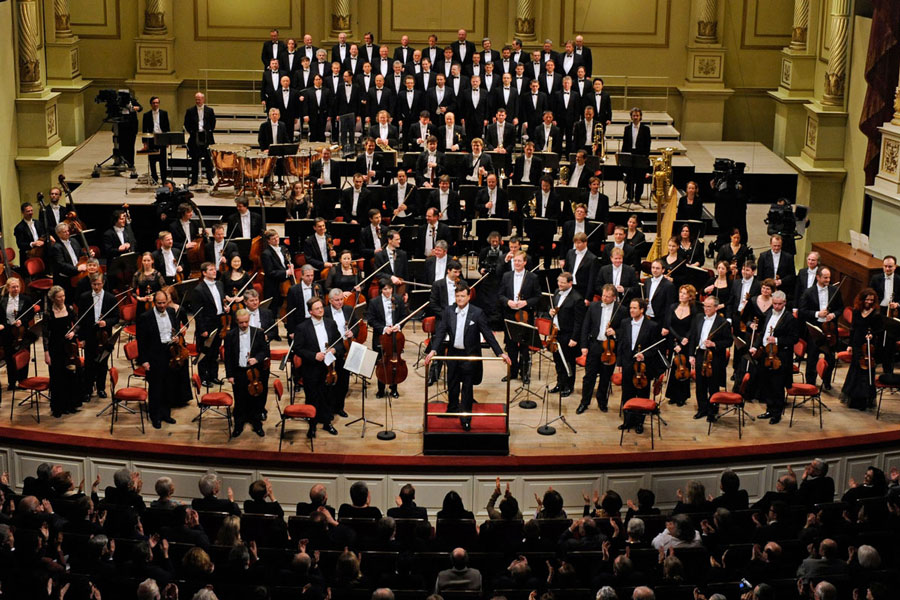On 22nd September 2008 the Staatskapelle Dresden celebrated its 460th jubilee. Founded by Prince Elector Moritz von Sachsen in 1548, it is one of the oldest orchestras in the world and steeped in tradition. Over its long history, many distinguished conductors and internationally celebrated instrumentalists have left their mark on this one-time court.
Gustav Mahler worked on his First Symphony in February and March of 1888, by integrating music that he had written earlier. The first performance was given on November 20, 1889, in Budapest, with the composer conducting. The First Symphony is indebted to such sources as Mahler’s Wayfarer songs, incidental music written for Der Trompeter von Säkkingen, yodelling, military fanfares, café music, the opening of Beethoven's Ninth Symphony, a love song he wrote in 1880, Reveille, and the German Ländler. This was Mahler’s first large and purely orchestral work and it took him some time to bring all his material together to create a lucid whole from the individual parts. When Mahler finally published the piece fifteen years later, he had discovered a new kind of symphony that linked the creativity and storytelling of the symphonic poem with the architectural organisation of the symphony as it was known. It is evident, at the time, that Mahler was experimenting with ways of creating overwhelming volumes of sound. He even suggested in the score that the expanded horn section should stand, bells raised, in order to surmount the rest of the orchestra during the finale.
When the piece was introduced in Budapest it was billed as a "Symphonic Poem in two parts" with three movements in part 1 and two in part 2. At its first performance the pastoral and idyllic Part 1 was in much better received than Part 2, with its ‘new romantic’ excesses. Mahler wrote to the critic Max Marschalk in March 1896, “At the time my friends persuaded me to provide a kind of program for the D major symphony in order to make it easier to understand. Therefore, I had thought up this title and explanatory material after the actual composition. I left them out… not only because I think they are quite inadequate and do not even characterise the music accurately, but also because I have learned through past experiences how the public has been misled by them.”
The first movement begins "like a sound of nature," with its overtly marked cuckoo calls, fanfares tuned to A-natural and scattered over seven octaves, and an effect is created by three offstage trumpets. Next comes a scherzo set to foot-stomping dances and yodelling, similar to material Mahler had used for his first songs in 1880. The third movement, Mahler says, is a satiric cartoon of "The Hunter's Funeral" a vision of a hunter's coffin drawn by animals, turned into musical life. The finale begins with a "flash of lightning from a dark cloud" Mahler claimed, "It is simply the cry of a wounded heart." Later the work returns to the pastoral themes of the first movement, but rather than setting off on a journey, headed straight for triumph.
Antonín Dvořák composed the Eighth Symphony between August 26 and November 8, 1889, and conducted the first performance on February 2, 1890, in Prague. He was eager, he said, to compose something “different from the other symphonies, with individual thoughts worked out in a new way.” This is his most rustic and idyllic work, and thus, in effect his Pastoral, like Brahms’ Second or Mahler’s Fourth. “Melodies simply pour out of me,” Dvořák proclaimed as he wrote, the first movement was finished in two weeks, the second a week later, and the remaining two movements in just a few days each. The Eighth Symphony brims with Czech folk tunes and the sounds of the Czech countryside. The music illustrates the tranquil landscapes and is thought to have drawn inspiration from the garden of Dvořák’s country home of Vysoká. Dvořák recreates the sweet sounds of nature, predominantly hunting and bird calls, as well as inserting dramatic fanfares. During a rehearsal of the trumpet fanfare in the last movement, conductor Rafael Kubelik professed, "Gentlemen, in Bohemia the trumpets never call to battle, they always call to the dance!" On August 12, 1893, Dvořák conducted his G major Symphony at the World’s Columbian Exposition in Chicago as part of a Bohemian Day program. By that time, he had already conducted it successfully, and always to an enthusiastic response, in Prague, London, Frankfurt, and Cambridge.
Alixandra Porembski, English Language Annotator



